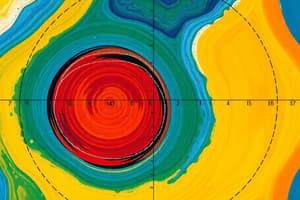Podcast
Questions and Answers
What is the primary function of lines of longitude?
What is the primary function of lines of longitude?
- To serve as a reference for locating places on Earth (correct)
- To divide the Earth into different climate zones
- To measure geographical features like mountains and valleys
- To act as barriers against ocean currents
How do time zones relate to lines of longitude?
How do time zones relate to lines of longitude?
- Every 15° of longitude difference roughly corresponds to a one-hour time difference (correct)
- Time zones are determined by the position of the sun at noon
- Time zones are only based on local weather patterns
- Each 30° of longitude corresponds to a one-hour time difference
What significant breakthrough aided in accurate longitude determination historically?
What significant breakthrough aided in accurate longitude determination historically?
- The use of compasses for navigation
- The discovery of longitude by ship captains
- The invention of maps
- The development of accurate chronometers (correct)
Which meridian serves as the reference point for all other longitudes?
Which meridian serves as the reference point for all other longitudes?
What technological advancement has significantly improved the measurement of longitude in modern times?
What technological advancement has significantly improved the measurement of longitude in modern times?
Why is accurate measurement of longitude essential?
Why is accurate measurement of longitude essential?
What is the approximate relationship between degrees of longitude and time zones?
What is the approximate relationship between degrees of longitude and time zones?
What is one application of precise longitude measurements?
What is one application of precise longitude measurements?
Flashcards
Lines of Longitude
Lines of Longitude
Imaginary lines running vertically around the Earth, connecting the North and South Poles. They are also known as meridians.
Longitude Measurement
Longitude Measurement
Measured in degrees, from 0° to 180° East and 0° to 180° West, relative to the Prime Meridian.
Prime Meridian
Prime Meridian
Located at 0° longitude, passing through Greenwich, England. Serves as the reference point for measuring longitude.
Importance of Longitude
Importance of Longitude
Signup and view all the flashcards
Measuring Longitude
Measuring Longitude
Signup and view all the flashcards
Longitude and Time Zones
Longitude and Time Zones
Signup and view all the flashcards
Key Lines of Longitude (Prime Meridian/ 180° East/West)
Key Lines of Longitude (Prime Meridian/ 180° East/West)
Signup and view all the flashcards
Global Significance of Longitude
Global Significance of Longitude
Signup and view all the flashcards
Study Notes
Lines of Longitude: Key Concepts
- Lines of longitude are imaginary lines that run vertically around the Earth, connecting the North and South Poles.
- They are also known as meridians.
- Longitude is measured in degrees, from 0° to 180° East and 0° to 180° West, relative to the Prime Meridian.
- The Prime Meridian, located at 0° longitude, passes through Greenwich, England, and serves as the reference point for measuring longitude.
Importance of Longitude
- Longitude provides a crucial spatial reference for locating places on Earth.
- It's essential for navigation and the accurate determination of time zones, as local times across different longitudes differ based on the Earth's rotation.
- Accurate longitude measurements are required for global positioning systems (GPS).
- Essential for plotting locations on maps and globes to facilitate communication. Precisely pinpointing a location in space and time facilitates a multitude of applications in various fields, like charting trade routes, creating maps, and undertaking scientific investigations.
Measuring Longitude
- Historically, determining longitude was a significant challenge often requiring sophisticated scientific instruments.
- Early methods involved observing the positions of celestial bodies and the use of sophisticated clocks.
- The development of accurate chronometers, which could keep precise time, was a major breakthrough in accurate longitude determination.
- Modern GPS technologies provide exceptionally precise longitude measurements.
Longitude and Time Zones
- Earth's rotation causes time differences across different longitudes.
- Each 15° of longitude difference roughly corresponds to a one-hour time difference.
- Time zones based on longitude ensure standard timekeeping across various regions and facilitate smooth communication and coordination across the globe.
Key Lines of Longitude
- The Prime Meridian (0°) serves as the reference point for all longitudes.
- 180° East and 180° West meridians are approximately antipodal, serving as reference points for mapping and measurement.
- Other significant lines of longitude exist and are relevant for local navigation and scientific study.
Global significance and applications
- Longitude is critical for many aspects of human activity, from navigation and shipping to meteorology and space exploration.
- Precise longitude measurements underpin accurate geospatial referencing, crucial in mapping, surveying, and exploration.
- This translates to diverse applications, such as maritime navigation, determining distances, charting, and accurately locating objects and phenomena on Earth.
- Global positioning (GPS) systems and other satellite navigation technologies utilize longitude data extensively.
Studying That Suits You
Use AI to generate personalized quizzes and flashcards to suit your learning preferences.




